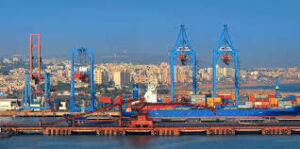GS-3: Infrastructure
Key Points:
- PM Modi inaugurated the ₹8,800-crore Vizhinjam International Deepwater Seaport in Kerala, marking India’s first specialized container transshipment facility.
- Developed through a PPP model by Adani Ports in collaboration with the Kerala government.
- Modi stressed that port-driven development will be pivotal for India’s maritime and economic advancement in the next decade.
Strategic Importance of Vizhinjam Port
- Its 20-meter natural depth allows it to accommodate large cargo ships without significant dredging.
- Positioned near major global shipping routes, ideal for international transshipment.
- Reduces reliance on foreign ports like Colombo and Singapore for cargo handling.
Economic and Developmental Impact
- Aligns with the Sagarmala initiative to strengthen logistics and coastal infrastructure.
- Expected to elevate India’s role in global maritime trade by:
- Cutting shipping time and costs.
- Improving logistical efficiency.
- Supporting Make in India and Ease of Doing Business through enhanced infrastructure.
- Modi also virtually launched ₹58,000 crore worth of projects in Andhra Pradesh, including support for Amaravati.
Private Sector’s Role
- Over the past decade, the PPP model has driven massive investments in port modernization.
- This approach has aligned Indian ports with global standards, preparing them for future challenges.
Scientific/Technical Terms:
- Container Transshipment Hub: A port facilitating cargo transfer between vessels for final destinations.
- Public-Private Partnership (PPP): Infrastructure projects co-funded and managed by private entities and the government.
Significance:
- Signals a focus on infrastructure-driven coastal growth.
- Strengthens India’s maritime independence, vital for trade and energy security.
- Aligns with strategic objectives like the Act East Policy, Blue Economy, and trade diversification.





